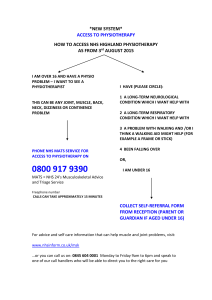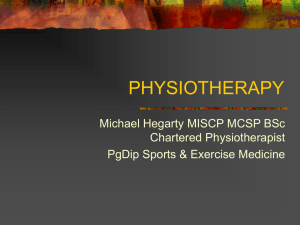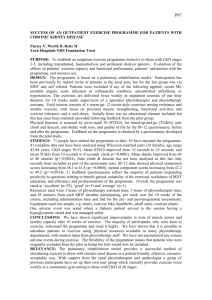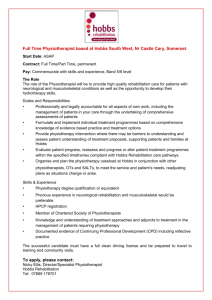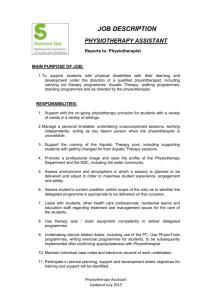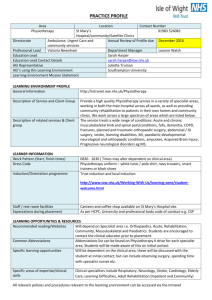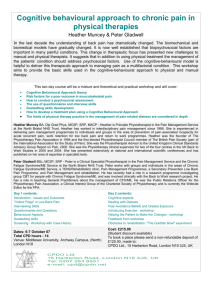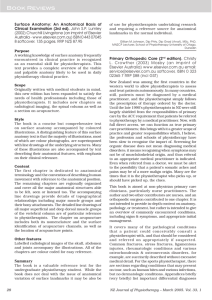branch - Volunteer news and resources
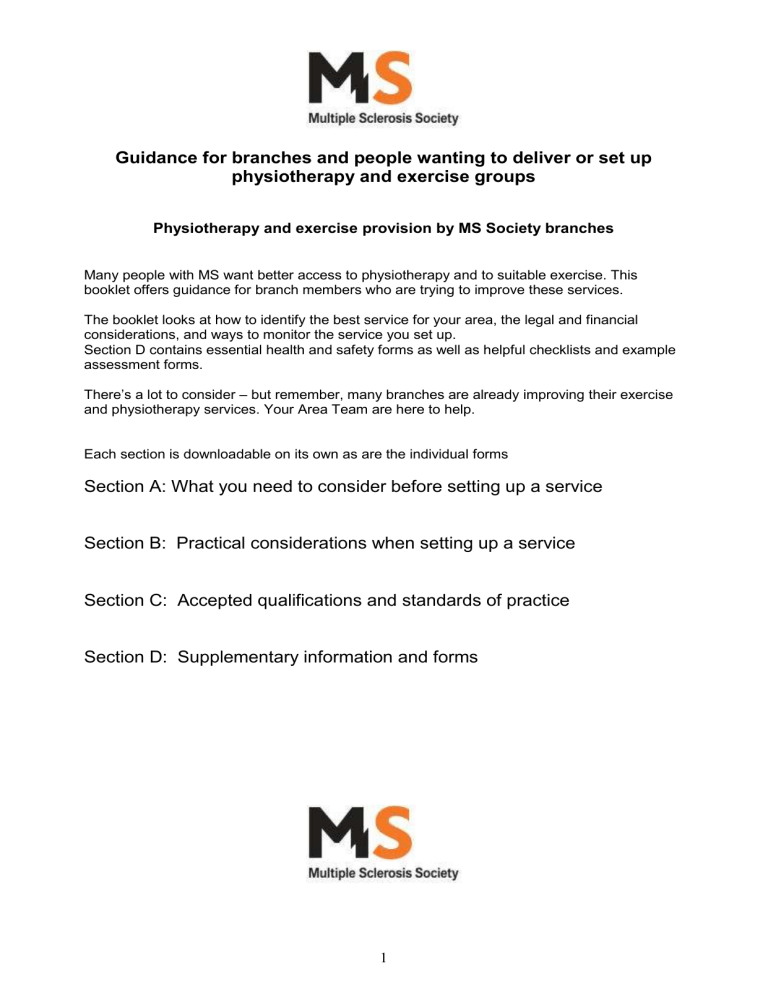
Guidance for branches and people wanting to deliver or set up physiotherapy and exercise groups
Physiotherapy and exercise provision by MS Society branches
Many people with MS want better access to physiotherapy and to suitable exercise. This booklet offers guidance for branch members who are trying to improve these services.
The booklet looks at how to identify the best service for your area, the legal and financial considerations, and ways to monitor the service you set up.
Section D contains essential health and safety forms as well as helpful checklists and example assessment forms.
The re’s a lot to consider – but remember, many branches are already improving their exercise and physiotherapy services. Your Area Team are here to help.
Each section is downloadable on its own as are the individual forms
Section A: What you need to consider before setting up a service
Section B: Practical considerations when setting up a service
Section C: Accepted qualifications and standards of practice
Section D: Supplementary information and forms
1
A. Things to consider before setting up a service
The first step is to consider what type of service you really need. Although one to one physiotherapy can be very helpful, it isn’t always the answer and should be provided by the
NHS in times of greater need. Sometimes general exercise is just as beneficial, especially if it is done in an enjoyable way which promotes social interaction at the same time.
It is important that you look at what is already provided & what people with MS want. Your area team should be able to help you with this and you could seek the views of your members using a simple questionnaire to ask about the services they receive and what they would like. See
Appendix 1 for an example.
Your area team can also help in other ways such as liaising with local NHS Managers or putting you in touch with other branches who might like to work with you to develop services. They can also contact the Physiotherapy team at National centre for more specific advice.
1. Physiotherapy
If you have already identified that local physiotherapy provision is not meeting demand, the next step is to know more about how these services fall short. Do they fail to meet standards recommended by the Government (see below), or is it just that they cannot be accessed easily or quickly? Knowing this will help you come up with the most efficient plan of action.
Are local services below government standards?
One way to assess this is by comparing the local services to the targets and recommendations set out by the Government in:
National Institute for Health and Clinical Excellence (NICE) Clinical guideline 8: Multiple
Sclerosis 2003
National Service Framework (NSF) for Long-term Conditions 2005
The free MS Society publication Translating the NICE and NSF guidance into practice: A guide for physiotherapists (Second edition, 2008) makes this assessment easier by detailing the relevant parts of both. Your area team can help you to interpret this.
Improve local NHS services
If you feel that local services do not match up with government recommendations, you should consider working with your area team to try to improve access to physiotherapy. Base your requests on what the Government guidelines say rather than what people with MS would like in an ideal world. Here are some examples of how you might use Government recommendations and targets to improve services:
Example – early rehabilitation
Local NHS commissioners will not have the resources to provide daily physiotherapy on an ongoing basis , so it’s fruitless to demand this. But they should, according to the
NICE guidelines (2003), be monitoring patients and providing “early rehabilitation” in time of need, such as following a relapse or after a period of illness. In addition, the
National Service Framework for Long-term Conditions (2005) states that early rehabilitation “…reduces the risk of preventable secondary complications and reduces length of stay in hospital and readmission rates”.
2
Example – self-management
There is also a lot of emphasis in Government papers on helping patients to selfmanage their condition. This creates the opportunity for therapists to develop exercise and education sessions or work to improve access to other resources by liaising with local branches, Therapy Centres or leisure services.
Example – influence and involvement
Almost all recent Department of Health documents have emphasised the need for service providers to consult with, listen to and involve patients when planning and delivering services. Now is a great time to have a say in how your local statutory services are provided, and to influence the long-term development of services. Your area team will be happy to help you to find out how you could become involved in to help make the voice of people with MS heard.
Make contact with your local NHS managers, through your area team to discuss how services might be improved. Many branches have successfully worked in partnership with their local
NHS providers to improve access to a physiotherapist with experience in helping people affected by MS (often known as a specialist neuro-physiotherapist Your area team can help you find the best solution for your local situation; if you have a particular issue where you feel you are not getting what you are entitled to, you could seek the assistance of the Policy and
Campaigns team at National centre. In relation to Functional Electrical Stimulation, you might find their campaigning pack helpful; this can be found on the MS Society website under Policy and Campaigns ‘Hot topics’ or you can order a copy by phoning the Helpline on 0808 8008000
What other options are there for improving physiotherapy services?
If working with your local NHS providers doesn’t get the results you need, you could look at:
Working with other charities which might have similar needs
– such as the Stroke
Association or Parkinson’s disease Association.
Speaking to your local MS Therapy Centre, which might already offer physiotherapy. Perhaps they could arrange for MS Society branch members to access their services. This is already happening in a number of Therapy Centres.
Providing an exercise group led by a physiotherapist or additional one-to-one physiotherapy sessions – by paying for physiotherapy.
Providing a physiotherapy service
If you decide to provide an exercise group or other sessions led by a physiotherapist, you’ll need to ensure the standard of the service. The most effective way to do this is to pay the NHS to use their physiotherapists. This relieves the branch of many responsibilities and provides a more comprehensive service. It also costs less to arrange services this way than employing a private physiotherapist. Your area team will be happy to help you to negotiate with your local
NHS provider.
If you are unable to obtain the services of an NHS physiotherapist, you might decide to work with a private one. This does, however, place responsibility on you to ensure that the therapist meets all the standards laid out in section C.
Whether you use an NHS or a private physiotherapist, you should set up a service level agreement (SLA) with the provider (see sections B and D)
Whichever route you take, ensure that any physiotherapist you use has appropriate knowledge and experience of MS for the service they are to provide. For example, some physiotherapists may have had limited experience of neurological conditions such as MS so would not be suitable for delivering specific one-to-one treatment; but they might be quite able to run group exercise sessions. The skills and experience of a physiotherapist will affect what they charge, so it’s worth trying t get the best fit for the work they will do.
3
Your area team will be happy to assist you and can liaise with the Programme lead for physiotherapy at National centre for specific advice.
2. Exercise
If you feel that access to exercise is what is needed, you may not need to engage the services of a physiotherapist. You might consider:
Making use of existing local services.
Paying an instructor such as a fitness trainer, Yoga or Pilates teacher to run sessions.
Making best use of local facilities
Local leisure centres might already offer suitable exercise opportunities. For example, they may run special swimming sessions when the pool will be less crowded or organise activities such as Boccia (a form of bowls) which can be played in a seated position. You could contact the leisure services department at your local authority or approach the facilities direct to find out what is available or persuade them to start something new
Attending or organizing sessions in local centres has some major advantages:
You are not responsible for insurance or the safety of the venue
People can do different activities suitable for their ability level & interests but still meet up socially as there are usually meeting & refreshment areas
There may be funding available through the leisure centre to support some activities and in any case it is likely to be cheaper than running classes elsewhere
Fitness trainers will be vetted & insured by the leisure centre
There are some interesting schemes running in both private and council leisure centres around the country as well as some Department of Health sponsored initiatives aimed at increasing access to exercise; for example in some areas, GPs can prescribe exercise which gives free or subsidised access to leisure facilities and many councils offer free swimming for certain client groups such as the over 60’s.
A scheme called the Inclusive Fitness Initiative aims to make sport and leisure more accessible for all so it is worth trying to find one of their affiliated centres. More information can be obtained from their website www.inclusivefitness.org . Search out what’s available in your area – neighbouring branches, local charities and your area team might all have useful knowledge of this.
Ensuring standards
Whatever form of exercise you want to organis e, it’s important to have confidence in the experience and suitability of the practitioner. Many disciplines have national bodies which train and register their practitioners and there is further advice about this in section C. If in doubt about the suitability of instructors or classes, you can always seek advice from a physiotherapist or consult the Physiotherapy programme lead at National Centre jpetty@mssociety.org.uk
As a starting point, you might find that other similar charities (such as the local Stroke
Association or Parkinson’s Disease Society) in the area know of facilities and practitioners they have used.
If you employ an exercise practitioner directly, it is important that they have appropriate experience and meet the minimum standards laid out in section C of this publication.
Providing services for all
4
It is worth bearing in mind that different types of exercise will suit different people so it may be helpful to find out what the majority would like and what people are already doing. The questionnaire in Section D will provide some of this information & you could produce a factsheet or database giving details and alert others to these facilities. You could also organise
‘taster’ sessions where people have a chance to try different activities
It might be helpful to put members in touch with each other for mutual support; sometimes having a ’buddy’ can make all the difference. For example, walking is good exercise but some people may lack the confidence to go out on their own. Likewise, someone might avoid swimming because they need just a little help to get changed. Even cycling is possible for some who thought they’d never ride a bike again – it might just take a little assistance and the right type of bike or tricycle. You might even be able to set up links with a local cycling, swimming or walking group whose members would be willing to act as ‘buddies’
5
.
B. Practical considerations when setting up a service
This section has more details about vital health and safety issues, financial plans and service monitoring.
Health and safety and risk assessment
There are a number of risk assessments which should be carried out with the assistance of your area team to ensure that every effort has been made to minimise risks and observe health and safety regulations. The main one is form VFRA
701A ‘Physiotherapy and exercise risk assessment’ but there others which you should complete for specific activities like water-based exercise or use of equipment such as exercise bikes. All of these are available from the fitness section on the branch health and safety site. Form VERA 903A has been developed to help you assess venues and is also available from the Events section on the branch health and safety site.
Risk assessments should be reviewed annually, or when anything has changed. Completed copies should be kept by the branch.
A health and safety audit including a review of risk assessments will be completed annually by your area team. Members of the MS Society Health and Safety Team will also carry out audits on an adhoc basis. It is important that we all have these records and procedures, to be as safe as possible and to protect the work of individuals and the Society should accidents happen.
If there is an accident or near miss, HSV: 722 Accident report form or HSV: 723 Incident report form should be completed and a copy sent to the person who is responsible for health and safety issues at the branch. If the accident is serious and has resulted in severe injury, the branch health and safety representative should immediately contact their area team who will make necessary arrangements.
Insurance
In the event of a problem such as an injury or complaint, both the branch and the MS Society as a whole have a ‘Duty of Care’. It is essential therefore that all activities have appropriate insurance cover.
As well as the venue being covered by public liability insurance, anyone leading a class or exercise session must also have their own professional and public liability insurance. This is their responsibility but you need to check their certificate (see section C below regarding physiotherapists’ insurance) and get them to sign a letter confirming their qualifications and insurance (see section D). These letters should be held by the branch.
The MS Society’s insurance will also cover most activities as long as they are properly run by someone with an appropriate qualification if in doubt as to whether your activity is covered by this insurance, you could contact the MS Society’s insurance brokers, Giles Insurance. The contact there is Andrew Copeland – 0121 200 4971, Andrew.copeland@gilesinsurance.co.uk
Service level agreement
Once you have found someone suitable to run your sessions, it is important that you set up a
Service Level Agreement (SLA). This is a simple form of contract which ensures that both parties are clear about the nature of the arrangement and their responsibilities. Your area team will help you write this in consultation with the Physiotherapy Team at National Centre.
Funding
6
It is important that you think about sustainability of a new service. We strongly recommend that you ask those participating to make a financial contribution, even if you have sufficient resources to pay for it at the start.
This should help to keep the eservice running even if funds run low, costs increase or you have people attending who cannot afford to contribute anything. You could have a suggested amount or just a system where people give what they can afford. You should keep records of contributions and numbers attending using a form such as the one in section D.
There are a number of grants available for which you could apply. You might also find there is money available through your local authority or PCT for the development of exercise-based initiatives. We suggest that you talk to your area team for advice on this as there will be local variations.
Monitoring and evaluation
It is important that you can demonstrate the benefits of what you are doing – it’s essential if you are seeking external funding in the form of grants or NHS support. But it’s important for any service we provide, so that people affected by MS and others who support us can see the value of the work we do.
Discuss with your physiotherapist or instructor how you will evaluate the effectiveness of the service. It is advisable to use a questionnaire such as the one in section D to try to measure outcomes. This form is designed to be given to the person before they start treatment for completion of the first two questions with the rest being answered on conclusion or after a defined period of time – after six months, for example.
Be sure you’ve got an effective booking system in place and keep records of those attending as well as the number of hours worked by the physiotherapist or instructor.
You should also think about how you will make sure that the service is open to all, making every effort to overcome financial, social or practical barriers. And bear in mind also that the service should be available to all people with MS not just branch members.
Of course, if demand exceeds supply you will have to consider how you will manage the service, but you should do this in conjunction with the therapist providing it. As a general rule, we recommend that you avoid raising expectations too high at the start perhaps by starting with a defined number of sessions.
Keeping National centre informed
With over 300 branches, plus ongoing national and regional work, it’s important that the Society can understand what is happening around the UK. Once you have a plan for developing services, please complete the form in section D and send it to your Area Team. This helps keep a record of the good work being done around the country and allows the national and regional staff to offer appropriate practical support.
7
C. Accepted qualifications and
Standards of practice
This section explains more about how you can be confident in the practitioners you employ or support.
Physiotherapy standards
Any physiotherapy service which a branch supports sets up or subsidises must be delivered by a physiotherapist registered with the Health Professions Council. They must adhere to professional standards and Codes of Conduct legally required of health care professionals who practise in the UK.
This is essential to ensure a good standard of care is being delivered and so that branches and the MS Society as a whole are covered by insurance and are compliant with legal requirements. This would be critically important in the case of a complaint being made or in the event of legal action being threatened or taken.
If you pay the NHS to use one of their physiotherapists, all issues described above and those relating to support, training and employment are taken care of by the NHS. However, iff a private arrangement is made directly with a physiotherapist, the branch committee is responsible for all these matters
Any physiotherapist must meet the following minimum standards:
1. They must be registered with the Health Professions Council (HPC) – this can be checked by visiting the HPC website at www.hpcheck.org
and entering ‘physiotherapist’ and the name or registration number of the person. Alternatively, you can ask to see their certificate. You will need to note the expiry date and check again at this time that registration has been renewed.
2. They must have professional and public liability insurance cover for £5 million, if working outside the NHS. They will have this if they are a member of the Chartered Society of
Physiotherapists (CSP) but you should ask to see their membership certificate to check they have current membership. Again, you will need to note the expiry date and check that membership is renewed.
3. They must adhere to the standards laid out in the following documents produced by the
Chartered Society of Physiotherapists (CSP) and the Health Professions Council: CSP
Rules of Professional conduct and Standards of Physiotherapy Practice , HPC Standards of conduct, performance and ethics and Standards of Proficiency for Physiotherapists .
4. They must have undertaken mandatory training including manual handling and resuscitation, which should be updated annually.
5. They must have had a Criminal Record Bureau (CRB) check
If a branch employs a physiotherapist directly, it is the branch’s responsibility to ensure that all the above is adhered to; therapists should sign the form HSV 743 in section D to confirm that
8
all the above is the case; this should be retained by the branch. All these issues are covered by the risk assessment VFRA 701A mentioned earlier. All forms are available from the Fitness section in the Branch zone of the website.
The physiotherapy team at National Centre can advise on all the above but have picked out the key aspects from the documents listed in point 3 for ease of use. This is all guidance that the physiotherapist must follow but you should be aware that this is what they should be doing.
Assessment
Before treating a patient, a physiotherapist must carry out an assessment to obtain basic information about the person – What issues need addressing? Are there are any reasons why any treatment techniques should be avoided?
Therapists should always carry out risk assessments prior to assessing or treating a patient.
They should take steps to minimise any risks to themselves or to patients, but should not start or continue with a procedure if they consider the risks to themselves or others to be unacceptable, even if requested to do so by a patient
Treatment and effect
The aims of any treatment should always be discussed with patients and their consent to treatment must be obtained and recorded. Ideally, goals should be set so it is clear what the patient is hoping to achieve through attending physiotherapy; this also helps with demonstrating effectiveness as does the use of outcome measures which you should encourage your physiotherapist to use.
Documentation
Appropriate sets of notes must be used by the physiotherapist to record necessary information about patients and each page should show the patient’s name and date of birth. Be aware that the physiotherapist will probably prefer to use their own notes; if this is the case, it is advisable to send an example to National Centre for the attention of the Physiotherapy Team. If the physiotherapist does not have a set of notes they wish to use, you should contact the
Physiotherapy Team at National Centre who can supply some. Notes should include details of the person’s medical and relevant social history, medication, current problems, assessment findings, consent to treatment and treatment plan. Ongoing treatment must also be recorded but in the case of regular attendance at group sessions, this can be done using an attendance sheet as long as nothing new or abnormal occurs.
All information must be recorded legibly and all notes must be written in permanent ink and clearly signed and dated as directed in Standard 14 of the CSP Core Standards of
Physiotherapy Practice . Patients have the right to access their notes but this should only take place after discussion with the physiotherapist.
Storage of notes
Patient notes are confidential and must be stored securely with access available only to authorized personnel. They are a legal document and must be retained for eight years after the conclusion of treatment
Confidentiality
You must ensure that no information about those receiving treatment is available to or discussed by anyone other than the patient themselves & their therapist; this may mean that your therapist will need a separate private area for one to one sessions.
Scope of practice and professional development
Physiotherapists must only work within their ‘scope of practice’ as defined in the CSP information paper PD001 Scope of Physiotherapy Practice 2008 . This means that a physiotherapist should only practice in an area of physiotherapy where they have appropriate knowledge, skills and experience. In this case, then, they should have experience working in neurology, and preferably with people with MS. If in doubt, the Physiotherapy Team can advise on whether a therapist has suitable experience. Physiotherapists must continue to develop their knowledge and skills in order to be able to work safely and effectively and to retain their
9
registration. In order to demonstrate this, they should have a Continuing Professional
Development Diary.
Professional conduct
Physiotherapists must at all times observe patient confidentiality, treat patients fairly and with respect, communicate effectively and obtain informed consent prior to assessment or treatment.
Duty of care
A physiotherapist has an individual professional ‘duty of care’ towards their patients but, in addition, a branch and the MS Society as a whole has a ‘vicarious duty of care’ towards anyone using services or facilities provided or arranged by them.
Contact details
Details of the person to be contacted in the case of an incident or emergency should be held for each patient, but must be kept confidential. It is probably best if the therapist keeps this information with their notes as long as they bring these to each session
Fitness trainer standards
Any fitness trainer you use must be qualified (see below) and have their own professional and public liability insurance cover.
Appropriate qualifications
Ideally, you should look for someone who is qualified to level 4 on the Register of Exercise
Professionals (REPs). This will ensure that they are competent to work in any setting and with special client groups. Someone at level 3 might be suitable if they have done additional training such as the YMCA fit specialist module at level 3 for working with disabled people. You can check someone’s registration or look for someone suitable by going to www.exerciseregister.org
. You could also ask your area team for further advice
Appropriate experience
Ideally whoever you use should have had experience of working with people with neurological conditions but if this is not possible, you could contact your local physiotherapy service or the
Physiotherapy Team at National Centre who may be able to arrange some training support; they can also help if you are having difficulty assessing suitability.
Assessment before starting
When a fitness trainer begins training with people they do not know, they will need to carry out a brief assessment and will require a medical fitness form known as a PAR Q to be completed by all potential participants. An example of this form is in section D or can be obtained from the fitness section of the on the branch health and safety site. On this example form, you will notice that there is a requirement for people to see their GP before commencing any exercise regime if they answer yes to one or more questions. It is essential that this form is completed by all those intending to participate in exercise sessions to ensure that no-one is put at risk. It is recommended that all those participating in any form of exercise class complete the disclaimer form HSV 741 which is available as a supplement to this document or from the Fitness section in the Branch zone of the website.
Insurance
You should also request sight of the trainer’s insurance certificate and ensure that they sign the form at Appendix 12 HSV 744.
Other instructors and teachers (for example, Yoga or Pilates
)
Yoga teachers should be able to show you evidence of training leading to a yoga qualification but there is no regulatory body for Yoga. If a teacher is registered with the British Wheel of
Yoga you can be sure they are qualified and have insurance but not all yoga teachers will be.
There are many different types of Yoga. Some are more vigorous than others whilst some
10
forms have more emphasis on relaxation, breathing and meditation. What is most important is that you find an experienced teacher who is able to adapt their approach to the needs and abilities of those in the class and has an understanding of MS or is at least used to working with people with disability and / or neurological conditions.
The MS Society is currently working with Yoga Aid, a charity from Australia to run some courses teaching Yoga instructors about MS; the Yoga Biomedical Trust runs courses in Yoga therapy which is the adaptation of yoga practices for people with health considerations.
It is highly recommended that you find someone who has done some additional training in teaching those with health conditions.
Pilates instructors must also have a qualification in Pilates even if they are a qualified physiotherapist or fitness trainer. Physiotherapists may have trained with the Australian
Physiotherapy and Pilates Institute (APPI); you can check this at their website, www.ausphysio.com or by phoning their London office on 02073723606. Other organisations offering Pilates training are listed at www.pilates.co.uk
which gives a brief summary of each and a link to their websites. You can also get information on Pilates classes in your area on this website but it is not necessarily comprehensive, offers no guarantees regarding quality as it is a commercial website. The Pilates Foundation.com (www. pilatesfoundation.com) is a non profit making organisation which offers training & keeps an accredited list of Pilates Foundation teachers in your area. Wherever possible, it is generally best to get recommendations from others who have used Pilates teachers locally if possible. Again you should try to find someone with experience of working with people with neurological conditions or at least with disability. A physiotherapist with additional training in Pilates would be ideal so it is probably a good idea to look on the APPI website first.
Yoga teachers and Pilates instructors may also be registered on the Register of Exercise
Professionals (REPs) in which case you can be sure they have a recognized qualification & insurance. See the section above for further information on REPs.
Any instructors or teachers must have their own professional and public liability insurance cover. As with fitness instructors, you should request sight of the trainer’s insurance certificate and ensure that they sign the form HSV 744 in section D
Tai Chi Union for Great Britain
Instructor Grades
Senior Instructors (S)
- normally will have at least 20 years experience of practising Chinese internal arts in depth; they may vote at General Meetings etc., stand for election to the Executive
Committee and are in theory Technical Panel Qualified.
Advanced Instructors (A)
- normally will have at least 8-10 years experience of practising Chinese internal arts in depth, they may vote at General Meetings etc.and stand for election to the Executive
Committee.
Intermediate Instructors (I)
- practice Chinese internal arts to an acceptable level; they may vote at General
Meetings etc., but not stand for election to the EC.
Basic Instructors (B)
- are continuing their apprenticeship in Chinese internal arts and able to teach at a basic level; they may attend but not vote or stand for election at General Meetings.
Choosing a Tai Chi class:
Because there are so many different approaches to the art, there are, obviously, a number of ways in which it can be taught. (See our What is Tai Chi page.) Some instructors teach predominantly health aspects, working with soft exercises, meditation and relaxation
11
techniques whilst others may also include a range of partner exercises like push hands, martial applications and weapon forms.
Podiatry Qualifications
DPodM or BSc(Podiatry)
This signifies that the Podiatrist has completed a full training course in podiatry at an approved institution. Originally this course was a diploma in podiatric medicine - DPodM but was later changed to a degree course - BSc.
NB:DipPodMed is not the same as DPodM.
SRCh
State Registered Chiropodist. Since July the 9th 2003 this title is defunct though is likely to be used by many Podiatrists for the time being as it may still be expected by the general public as a sign that the Podiatrist is fully qualified. The current form of registration with the state is given by the new Health Professions Council.
MChS or FChS
This means that the Podiatrist is a member or fellow of The Society of Chiropodists and
Podiatrists. A practicing member of this society is assured of having professional indemnity insurance cover.
Some Podiatrists may have other letters after their name that signify further qualifications, for example F.C.Pod(S) for surgery but the above letters are important to know when seeking treatment for the majority of ailments.
HPC registration
HPC registration, means registration with the Health Professions Council . This is the regulatory board for chiropody/podiatry, physiotherapy, occupational therapy and others in the Allied
Health Professions. On July the 9th 2003 the HPC replaced the old Council for Professions
Supplementary to Medicine (CPSM). The CPSM set the standards for State Registration and
NHS employment which for Podiatrists/Chiropodists was a minimum of 3 years full time training at an approved institution leading to a degree or diploma in podiatric medicine. Registration with the new HPC ensures the practitioner meets certain minimum standards of education though unlike the old CPSM it does not guarantee that the Podiatrist/Chiropodist holding registration has completed an approved course.
If not all registered Podiatrists have completed an approved course, who are the others on the
HPC register?
In order to regulate the majority of people working as Chiropodists/Podiatrists the HPC allowed onto the register anyone who applies for HPC registration and who meets a minimum set of requirements, through a process known as grandparenting. Brief details of which you can view here - HPC grandparenting FAQ . In plain English this means that someone who has completed less than an approved 3 year course but who has been working privately as an unregistered
Podiatrist for at least three years had a chance to become registered and would then be regulated.
How can I be sure who's who?
This has actually been made more difficult by the Health Professions Council who insist that the obvious differences in training are to be ignored and will only state that all Podiatrists meet their new "minimum standards of proficiency". The HPC have a list of currently approved courses
12
that are without exception BSc courses. This could well lead members of the public to expect that all registered Podiatrists are degree educated which is now not the case. As there is no requirement for a Podiatrist to declare their training level it is up to the patient to ask. Firstly ask if they are a HPC registered Podiatrist, it is a criminal offense to falsely claim they are. If they are registered you can further ask if they have a degree or 3 year diploma in podiatry (BSc or
DPodM), it is a breech of the HPC regulations to falsely claim they have. If there is any show of protest at this or if they will only insist they are 'Fully Qualified' but won't be specific, it could well mean they are not
What is a Foot Health Practitioner?
Many of those previously using the titles Chiropodist or Podiatrist who have not gained HPC registration, either through choice or because they were not eligible, have now adopted the title
'Foot Health Practitioner' to replace Chiropodist/Podiatrist which they can no longer use. This title is not protected in law which effectively means anyone can use it regardless of training levels. Courses are now available that offer a total of only 11 days practical tuition, after which students will call themselves "Fully trained and qualified Foot Health Practitioners" and will advertise the same medical treatments as those offered by Podiatrists. Clearly a Foot Health
Practitioner course is not to be confused with the 3 years of full time training needed to become a Podiatrist.
Acupuncture
We recommend you use a British Acupuncture Council member It is very important to check that your acupuncturist is safe and competent. Acupuncture in the UK is not currently regulated by government
All members of the BAcC can offer you the following assurances:
BSc or BA degree level training or its equivalent in traditional acupuncture, Chinese medicine, and western biomedical sciences including anatomy, physiology and pathology (3,600 hours of study)
Compliance with current UK health and safety legislation
Full medical malpractice and public/products liability insurance cover
Expert practice skills maintained by following a mandatory individual programme of continuing professional development (CPD)
Regular updates from the BAcC regarding practitioners' professional obligations to the public compliance with BAcC Code of Safe Practice and Code of Professional Conduct
Patient access to the BAcC complaints and disciplinary procedures
English language skills at least equivalent to those required of doctors and nurses working in the UK
Acupuncturists registered with the BAcC carry the letters MBAcC after their name.
13
D. Supplementary information and forms
1.
Questionnaire about available physiotherapy services
2. Blank Service Level Agreement Form
3. Data collection form
4. Daily record of treatment
5. Questionnaire about benefits from physiotherapy / exercise
6. Pro forma outlining proposed new physiotherapy or exercise services
7. Physical Activity Readiness Questionnaire (PAR-Q)
8. Exercise disclaimer form
Form 1
Questionnaire about available physiotherapy services
14
1. Are you able to get physiotherapy treatment through the NHS if you
feel you need it? Yes / No
2. If yes to 1, how do you access physiotherapy? a. Self refer b. via GP c. via Neurologist d. via MS nurse e. other health care professional f. other
(Delete as applicable)
3. How long do you normally have to wait for your Physio to start?
……………………………………………………………………………………………………
……………………………………………………………………………………………………
4. How many sessions do you receive on average and does this meet your needs?
…………………………………………………………………………………………………..
……………………………………………………………………………………………………
5. Have you ever received non NHS physiotherapy? Yes / No a. If so why, where
………………………………………………………………………… b. How much? ........................................................................................................... c. It would also be helpful to know how much you pay if you are happy to provide this information …………………………………………………………………………..
6. Have you been given the opportunity to attend any exercise sessions? Yes / No
If so please give details ………………………………………….............................................
………………………………………………………………………………………………………
7. Have you been given any advice regarding how to manage your MS yourself? (E.g. exercise, fatigue management ) ………………………………………………………………..
……………………………………………………………………………………………………..
……………………………………………………………………………………………………..
8. Have you had a visit from a physiotherapist at home? Yes / No a. If not, would this be helpful and why? ...................................................................
…………………………………………………………………………………………………
…………………………………………………………………………………………………
9. If you have not received any physiotherapy but would like some, please explain what problems you think it would help with and what type of service you would like to receive ……………………………………………………………………………………………
…………………………………………………………………………………………………….
………………………………………………………………………………..……………………
…………………………………………………………………………………………………….
…………………………………………………………………………………………………….
10. Would you like the opportunity to do more exercise? Yes …/ No…….. a. If so what sort of exercise would you be interested in?
………………………………………………………………………………………………..
15
………………………………………………………………………………………………..
……………………………………………………………………………………………….. b. If you already exercise, please tell us what you do …………………………………
…………………………………………………………………………………………………
…………………………………………………………………………………………………
………………………………………………………………………………………………...
Form 2
Service Level Agreement Form
Please see accompanying guidance for details of how to complete this form
Section 1 – Key information
16
Agreement between:
Service commissioner
And
Service provider
Type of service
Service duration
Start / finish date
Review / report
Frequency
Section 2 - Service Specification
1. Description of parties supporting the service
2. Service that will be provided
3. Terms of service
4. Costs
5. Payment arrangements
6. Provision of service
7. Managerial and support services
8. Quality
9. Objectives and outcomes
10. Review and monitoring of the service
11. Variation
12. Termination of agreement
17
For and on behalf of MS Society: ………………………………. Branch
Signature: __________________________________________________
Title: _____________________________________________________
Address: ___________________________________________________
Phone: ____________________________________________________
Date: ______________________________________________________
For and on behalf of provider: ……………………………………Organisation
Signature: __________________________________________________
Title: ______________________________________________________
Address: ___________________________________________________
Phone: _____________________________________________________
Date: ______________________________________________________
For more information contact servicedevelopment@mssociety.org.uk
Date Number attending
1:1sessions
Form 3
Data collection form
Number attending groups
Number of new people
Amount of money collected
18
Amount of money paid
Running total
Date: ……………………….
Name
Form 4
Daily record of treatment
One to one treatment
19
Group session
Form 5
Questionnaire about benefits from physiotherapy / exercise
It would be very helpful if you could complete the following questionnaire which will enable us to evaluate the service you have been using and may also help us to demonstrate the need for improved services in your area.
Age:…………….. Gender: Male / Female
20
Time since diagnosis:…………………………………………………………..
Current level of physical ability (e.g. whether able to walk, transfer, look after yourself without help)…………………………………………………….
……………………………………………………………………………………
……………………………………………………………………………………
1. What did, do you expect to gain from having physiotherapy / hydrotherapy / attending exercise classes? (delete as applicable)
…………………………………………………………………………………………………………
…………………………………………………………………………………………………………
…………………………………
2. What specific issues or problems do, did you want the physiotherapy, exercise to address?
(Try to be as specific as possible e.g. “enable me to get in and out of the car” or “reduce the pain in my arm”)………………………………………………………………………………………
………………………………………………………………………………………………………………
………………………………………………………………………………………………………………
………………………………………………………………………………………………………………
2a Which of the above are, were you most hoping physiotherapy/ exercise would help with?
.................................................................................................................................................
………………………………………………………………………………………………………….
…………………………………………………………………………………..………………………
………………………………………………………………………………………………………….
2b Please try to rate the severity of this main issue as it is, was before treatment on the scale below. 0 indicates that it does not affect you at all and 10 is so severe that it is unbearable or prevents you from doing anything:
No effect 0….1….2….3….4….5….6….7....8….9....10 Extreme effect
3. What in particular has improved as a result of receiving physiotherapy/ exercise? Please try to be specific and give examples where possible e.g. “now able to stand for long enough to do the washing up i.e. 5 minutes” or “wake up less in the night i.e. twice instead of 3 times”
……………………………………………………………………………………………………...
……………………………………………………………………………………………………….
……………………………………………………………………………………………………….
……………………………………………………………………………………………………….
3a Please try to rate the main issue described above as it is, was after treatment:
No effect 0….1….2….3….4….5….6….7....8….9....10 Extreme effect
4. How has receiving physiotherapy/exercise affected your life as a whole? (This refers more to your general quality of life and how you feel)
………………………………………………………………………………………………………….
………………………………………………………………………………………………………….
…………………………………………………………………………………………………………..
…………………………………………………………………………………………………………..
5. Have other people such as family members or carers noticed any changes? Yes / No
Tell us more……………………………………………………………….
……………………………………………………………………………….
……………………………………………………………………………….
21
6. How convenient was the service e.g. in relation to times of appointments, location, transport etc? ………………………………………………………………………………………………….
………………………………………………………………………………………………………..
………………………………………………………………………………………………………..
7. Were you given helpful information about available treatment options? Yes / No
Tell us more ……………………………………………………………….
……………………………………………………………………………….
8. If you have been attending physiotherapy, do you feel you will be able to maintain any improvements made when it stops? Yes / No
Tell us more…………………………………………………………………
………………………………………………………………………………..
………………………………………………………………………………..
Form 6
Outline of suggested service
Pro forma outlining proposed new physiotherapy or exercise services
Frequency For example: once per week
22
Number of hours per week
Number of staff providing service
Are staff qualified or assistants?
Nature of service
Provider
Contribution to be paid by users
Therapy paid for
Funding obtained
Where from?
Process of setting up service
Consultation with members
For example: classes or one to one
NHS / private / MS therapy centre / fitness instructor / Other
(specify)
Yes/No Amount?
Yes/No Amount?
Yes/No Amount?
MS Society / Grants e.g. lottery / branch / other
National Centre staff involved
Negotiation with NHS
Service level agreement used
Liaison with others e.g. questionnaires used Yes / No
LSDO / SDO/ Physio team
Yes / No
Yes / No
Branches / MS therapy centres / leisure centres / local authority / other. Delete or add as applicable
Checks completed
Physiotherapy risk assessment VFRA: 701A completed
Venue risk assessment VERA 903A completed
If not NHS employed, letter signed confirming registration, insurance, income declaration etc
Procedures and documentation in place
Secure storage for notes arranged
Documentation agreed with physio
Register to record attendance set up
Incident reporting procedure agreed with
Yes / No
Yes / No
Yes / No
Yes / No
Yes / No
Yes / No
Yes / No
23
physiotherapist
Form 7
24
Physical Activity Readiness Questionnaire (PAR-Q)*
A Questionnaire for People Aged 18 to 69
Regular physical activity is fun and healthy and safe for most people. Increasingly more people are starting to become more active. However, some people should check with their doctor before they start becoming much more physically active.
If you are planning to become much more physically active than you are now, start by answering the seven questions in the box below. If you are between the ages of 18 and
69; the PAR-Q will tell you if you should check with your doctor before you start. If you are over 69 years of age and are not used to being very active; check with your doctor in any event.
Please read the question carefully and answer each one honestly by marking YES or NO.
Has your doctor ever said that you have a heart condition and that you should only do physical activity recommended by a doctor?
Do you feel pain in your chest when you do physical activity?
In the past month, have you had chest pain when you were not doing physical activity?
YES NO
Do you lose your balance because of dizziness or do you ever lose consciousness?
Do you have a bone or joint problem that could be made worse by a change in your physical activity?
Is your doctor currently prescribing drugs (e.g. water pills) for blood pressure or heart condition?
Do you know of any other reason why you should not do physical activity?
If you answered yes to one or more questions: Talk with your doctor by phone or in person
BEFORE you start becoming much more physically active or BEFORE you have a fitness appraisal. Tell your doctor about the PAR-Q and which questions you answered YES.
You may be able to do any activity you want - as long as you start slowly and build up gradually.
Or, you may need to restrict your activities to those which are safe for you. Talk with you doctor about the kinds of activities you wish to participate in and follow his/her advice.
If you answered no to all questions: you can be reasonably sure that you can start becoming much more physically active. The safest and easiest way is to begin slowly and build up gradually.
Delay becoming much more active: if you are not feeling well because of a temporary illness such as cold or a fever - wait until you feel better; or if you are or may be pregnant - talk to your doctor before you start becoming more active.
Please note: If your health changes so that you then answer YES to any of the above questions, tell your fitness or health professional. Ask whether you should change your physical activity plan.
Informed Use of the PAR-Q: The MS Society and its agents assume no liability for persons who undertake physical activity, and if in doubt after completing this questionnaire, consult your doctor prior to physical activity.
"I have read, understood and completed this questionnaire. Any questions I had were answered to my full satisfaction."
Print name: Signature: Date:
Name of Parent or Guardian:
(For participants under the age of 18)
Signature:
* Form reviewed annually; if the sessions change or if the person ’s condition changes.
25
Form 8
Exercise disclaimer form HSV: 741
D i i s c l l a i i m e r r F o r r m *
MS SOCIETY ………………………………………………………………………………………. BRANCH
Name:
………………………………………………………………………. Date: ………………………..
I acknowledge that the Multiple Sclerosis Society of Great Britain accepts no liability for any injury caused by the use of the equipment, activity or therapy other than in respect of injury resulting from the negligence of the Society or its employees acting in the course of their employment.
Section 1: Please fill in the following in as much detail as you can. The MS Society branch will keep your information securely in accordance with the Data Protection Act 1998.
26
Address: ………………………………………………………………………………………………………...
………………………………………………………… Post Code: ………………………………..............
Telephone number: ………………………………… E mail: …………………………………………..…
Emergency contact: …………………………………………………………………………………………..
Section 2: Activity/ therapy: (to be completed by all; please specify activity/therapy e.g. swimming, exercise class, alternative therapy, use of exercise bike, taking part in branch events such as wheel and walk, fire walking, abseiling etc): ………………………………………………………………………..
………………………………………………………………………………………………………...................
I acknowledge that I am participating in the activity/therapy detailed above at my own risk. I understand that before commencing an activity which involves physical exercise, I should complete a
Physical Activity Readiness Questionnaire** (HSV 712) and consult my Doctor if indicated, unless I have recently been assessed by an appropriate health care professional to ensure that this activity is suitable for me.
Print name: …………………………………………… Signature: …………………………………………
Section 3: Equipment: (to be completed if applicable; specify what equipment is to be used e.g. exercise bike, Nintendo Wii etc.): ……………………………………………………………………….........
………………………………………………………………………………………………………....................
I confirm I have been given advice/instructions regarding the use of the equipment detailed above. I agree that I will only use it as per the manufacturer ’s instructions*** or as directed by a physiotherapist or qualified instructor***.
Print name:
…………………………………………… Signature: …………………………………………
Section 4. Yes No
Do you require any special help during the activity?
If no carer is available to help with personal needs such as getting dressed are you willing for a volunteer to help you?
Print name: …………………………………………… Signature: …………………………………………
*Form reviewed annually, if the sessions change or if the member’s condition changes.
**Attach copy of HSV: 712 Physical Activity readiness questionnaires if used.
***Attach record of advice give n and/or where copy of manufacturer’s instructions provided.
27
